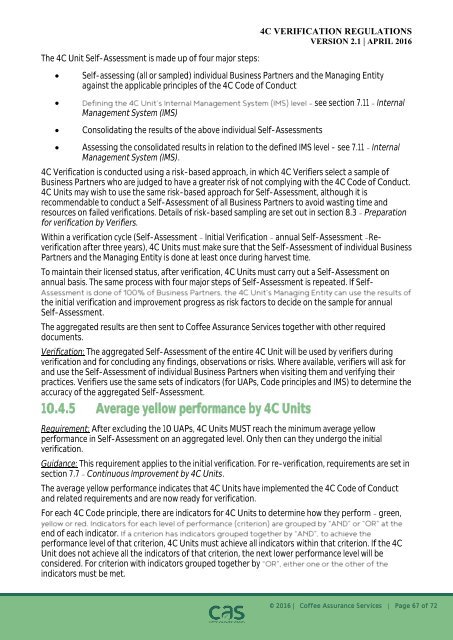VERIFICATION REGULATIONS
2byfvKv
2byfvKv
Create successful ePaper yourself
Turn your PDF publications into a flip-book with our unique Google optimized e-Paper software.
The 4C Unit Self-Assessment is made up of four major steps:<br />
<br />
4C <strong>VERIFICATION</strong> <strong>REGULATIONS</strong><br />
VERSION 2.1 | APRIL 2016<br />
Self-assessing (all or sampled) individual Business Partners and the Managing Entity<br />
against the applicable principles of the 4C Code of Conduct<br />
see section 7.11 Internal<br />
Management System (IMS)<br />
<br />
Consolidating the results of the above individual Self-Assessments<br />
Assessing the consolidated results in relation to the defined IMS level - see 7.11 Internal<br />
Management System (IMS).<br />
4C Verification is conducted using a risk-based approach, in which 4C Verifiers select a sample of<br />
Business Partners who are judged to have a greater risk of not complying with the 4C Code of Conduct.<br />
4C Units may wish to use the same risk-based approach for Self-Assessment, although it is<br />
recommendable to conduct a Self-Assessment of all Business Partners to avoid wasting time and<br />
resources on failed verifications. Details of risk-based sampling are set out in section 8.3 Preparation<br />
for verification by Verifiers.<br />
Within a verification cycle (Self-Assessment Initial Verification annual Self-Assessment Reverification<br />
after three years), 4C Units must make sure that the Self-Assessment of individual Business<br />
Partners and the Managing Entity is done at least once during harvest time.<br />
To maintain their licensed status, after verification, 4C Units must carry out a Self-Assessment on<br />
annual basis. The same process with four major steps of Self-Assessment is repeated. If Selfthe<br />
initial verification and improvement progress as risk factors to decide on the sample for annual<br />
Self-Assessment.<br />
The aggregated results are then sent to Coffee Assurance Services together with other required<br />
documents.<br />
Verification: The aggregated Self-Assessment of the entire 4C Unit will be used by verifiers during<br />
verification and for concluding any findings, observations or risks. Where available, verifiers will ask for<br />
and use the Self-Assessment of individual Business Partners when visiting them and verifying their<br />
practices. Verifiers use the same sets of indicators (for UAPs, Code principles and IMS) to determine the<br />
accuracy of the aggregated Self-Assessment.<br />
10.4.5 Average yellow performance by 4C Units<br />
Requirement: After excluding the 10 UAPs, 4C Units MUST reach the minimum average yellow<br />
performance in Self-Assessment on an aggregated level. Only then can they undergo the initial<br />
verification.<br />
Guidance: This requirement applies to the initial verification. For re-verification, requirements are set in<br />
section 7.7 Continuous Improvement by 4C Units.<br />
The average yellow performance indicates that 4C Units have implemented the 4C Code of Conduct<br />
and related requirements and are now ready for verification.<br />
For each 4C Code principle, there are indicators for 4C Units to determine how they perform<br />
green,<br />
end of each indicator.<br />
performance level of that criterion, 4C Units must achieve all indicators within that criterion. If the 4C<br />
Unit does not achieve all the indicators of that criterion, the next lower performance level will be<br />
considered. For criterion with indicators grouped together by<br />
indicators must be met.<br />
© 2016 | Coffee Assurance Services | Page 67 of 72


